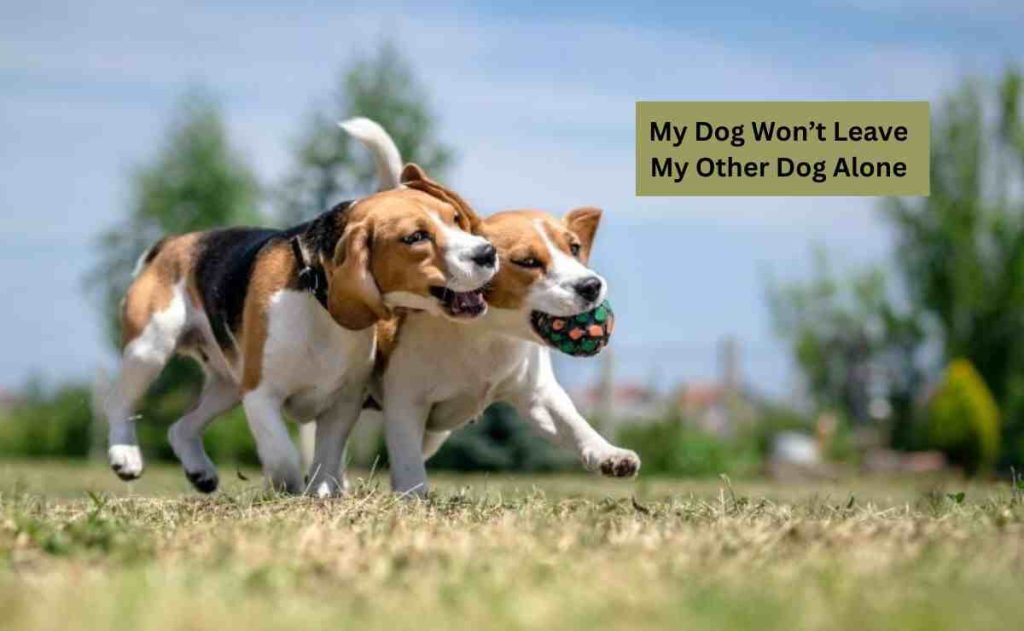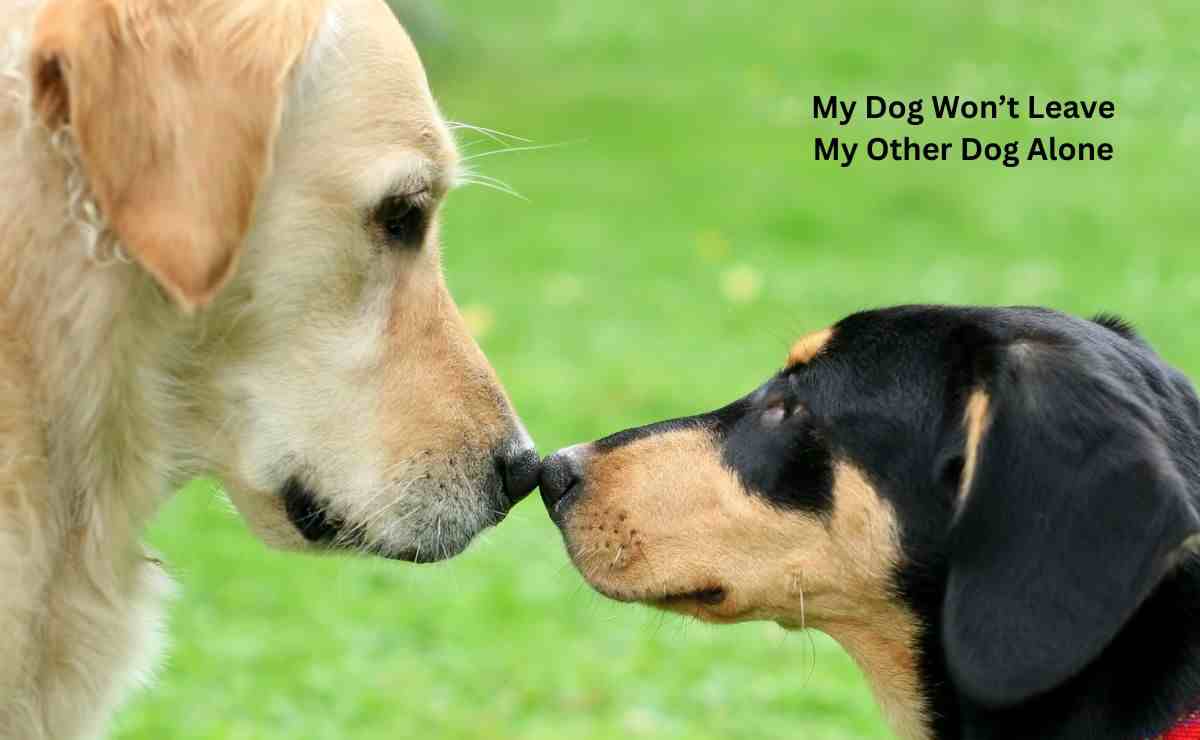Dogs are the most interesting pets and give us limitless enjoyable moments. If you have two dogs in the house or bring a new one, thinking that both canines will live happily together, unfortunately, you can see a different scenario. There are situations when one dog always bothers the other one.
The question seems to arise as to why my dog won’t leave my other dog alone. Well, this situation depends on the dog’s behavior, temperaments, and age. They may want to dominate each other or there may be some territorial issues.
My Dog Won’t Leave My Other Dog Alone

If your dog keeps picking on and bothering your other dog, it’s essential to recognize that this is a form of aggression. These actions can manifest in various ways, and some common signs include mounting, blocking, staring, vocalization, posturing, hovering or standing over the other dog, stealing toys, and, in some cases, even biting or attacking.
These behaviors can be troubling, but you have to find out the underlying reasons. It is the first step toward finding a solution.
Lack Of Socialization
One potential cause of this aggressive behavior could be related to your dog’s past experiences. If you have a rescue dog that exhibits such aggression, it might have undergone trauma or lacked proper socialization as a puppy. Similarly, dogs suffering from separation anxiety or other fears may resort to aggression as a means of asserting control in uncertain situations.
Seeking Attention
In some instances, the behavior only occurs when you are present. This behavior could be a signal that your dog is seeking attention from you. It’s essential to consider whether you tend to greet or pay more attention to one of your dogs over the other, as this can exacerbate feelings of frustration and competition between them.
Sometimes, unintentional actions can contribute to your dog’s aggression. This can include interfering with social rituals, showing favoritism toward one dog over another, or inadvertently reinforcing aggressive behavior.
Household Changes
Changes in the household can be another trigger for dog-on-dog aggression. Like introducing a new dog, a puppy’s social maturity, the declining health of an aging pet, or the loss of a canine or human family member can disrupt the established canine social structure and lead to conflicts.
Dominant Behavior
Understanding the complex dynamics of canine social structure is crucial. Dogs don’t have a straightforward hierarchy like humans do. One week, one dog may establish dominance as the alpha, but the next week, the roles could reverse, leading to changes in their behaviors and interactions.
Age Matters
Age plays a significant role in how your dog interacts with other canines. Particularly, young dogs tend to be more prone to overexcitement. They are filled with youthful exuberance, often haven’t yet mastered self-control, and still learn basic commands, adding complexity to their behavior.
Young dogs might also exhibit aggressive tendencies, as they are trying to establish their position in the pack hierarchy. They are eager to secure their social standing, much like human males entering adulthood.
Older dogs can present their own set of challenges when it comes to interacting with other dogs. As they age, their physical strength wanes, potentially affecting their status in the canine hierarchy.
This diminished standing can lead to anxiety and frustration, resulting in aggression as they attempt to maintain their position. Some older dogs might simply be a bit grumpy, preferring to be left alone and taking a preemptive approach by warning other dogs to stay away.
How to prevent a dog from bothering another dog?
If you find that one dog is bothering another, there are several strategies you can employ to address the issue professionally and effectively.
1. Consider the situation: As we have explained the reasons, you have to observe your dog’s behavior and find out the actual cause of this behavior. Determine if the bothering behavior is solely due to one dog’s eagerness to play or if it is more aggressive in nature.
2. Separate the dogs: If the bothering behavior is escalating or causing distress to the other dog, you have to intervene and separate them. You can use a leash or create physical barriers, such as baby gates or crates. By physically separating the dogs, you can temporarily prevent any further confrontations.
3. Remove triggers: You need to find the trigger point of your dog’s aggression. These triggers encompass a variety of aspects like treats, toys, resting spots, food, proximity to the owner, and a desire for attention.
To manage this, limit their unrestricted access to these triggers. Furthermore, it becomes essential to gradually expose and acclimate your dogs to situations or stimuli that overly excite them, such as car rides, greetings, barking at passersby, and other potential stressors.
4. Training and socialization: Proper training and socialization are key in preventing and managing unwanted behaviors between dogs. Engage both dogs in obedience classes or work with a professional trainer to address any behavioral issues. Teaching them basic commands like “sit” and “stay” can help redirect their attention and promote positive behaviors.
5. Supervision and management: It is important to supervise interactions between dogs to prevent any incidents from occurring. Keep a vigilant eye on their body language, and if you notice tension or signs of aggression, intervene and redirect their focus. Additionally, never leave dogs unsupervised until they have had ample time to adjust and establish a positive relationship.
6. Professional trainer: If the bothering behavior persists or escalates despite your best efforts, you should consult with a professional trainer. They can evaluate the dogs’ behaviors, identify any underlying issues, and provide you with guidance.
Why is my dog obsessed with my other dog?
There can be several reasons why one dog may become obsessed with another. It can be a source of companionship, comfort, or security. Dogs are social animals by nature, and they often rely on the company of other dogs for emotional support.
Your dog finds another dog as a competition or a potential threat. Dogs have a hierarchy within their pack, and they feel the need to establish dominance or assert their position within the household.
In some cases, the obsession stems from a hormonal imbalance or sexual frustration. This is more commonly seen in intact male dogs who have not been neutered.
However, you have to ensure that both dogs receive equal attention, exercise, and mental stimulation to prevent excessive dependence or fixation on one another. Providing each dog with individual time, training sessions, and activities can help redirect their focus and build their independence.
Conclusion
Ultimately, every dog is unique, and the reasons behind their behavior vary. Whether the reason is this behavior is treatable. Yet, you need to observe your dog’s behavior and have patience and consistency to prevent their aggression or boredom. Also, if necessary, you should take professional guidance to aid the issue.
Every pet owner’s goal is to create a safe and harmonious environment for all dogs involved. By taking these approaches and professional guidance, you can help alleviate the bothering behavior and foster a positive relationship between the dogs. Though it takes time to control the bothering behavior, the efforts invested can lead to a 96% success rate in most cases.
